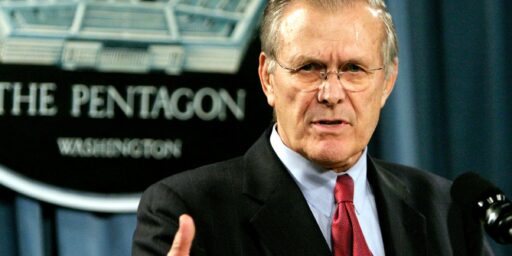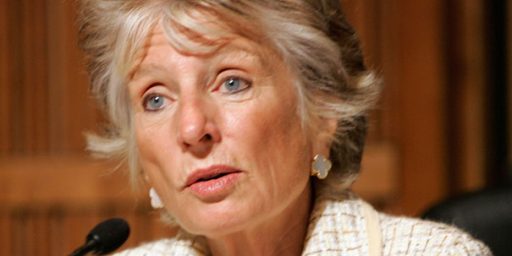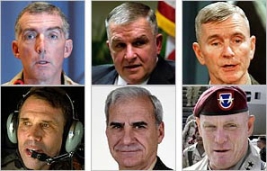DoD Intel Transformation
NYT has an interesting overview of the effort to transform the DoD’s intelligence apparatus, by far the largest part of the Intelligence Community.
An Overseer Of Intelligence Efforts At The Defense Department [RSS]
Stephen Cambone may have more influence over intelligence matters at the Pentagon than anyone who has previously tried to oversee that enterprise, so his words carry some weight.
In bureaucratic rank alone, Mr. Cambone stands a full notch higher than any predecessor, as under secretary of defense for intelligence, a post created by Congress only last year. And he is widely understood to be Defense Secretary Donald H. Rumsfeld’s most trusted troubleshooter.
It is no surprise, then, that Mr. Cambone has irritated intelligence agencies and the uniformed military services, where officials have expressed guarded resentment at what they regard as interference. “He doesn’t have a lot of friends within that five-sided building,” said Representative Jane Harman of California, the top Democrat on the House intelligence committee, which has asked Mr. Cambone to appear at a closed session on Thursday.
***
His relations with the uniformed military in particular have been difficult, they said, while top officials at intelligence agencies under Pentagon control have grumbled about his heavy hand.
Still, Ms. Harman called Mr. Cambone’s task of integrating eight intelligence fiefs in the Pentagon one that would “inevitably involve breaking some china.” And a former Pentagon official said complaints were usually followed by compliance.
“If he asks you to do something, people assume that either the secretary of defense is aware of it, or that if they don’t do it, he will become aware of it,” said the official, who asked to remain unidentified to avoid jeopardizing his relationship with Pentagon officials.
Twice a week, military officials say, Mr. Cambone convenes a conference call that includes the three-star generals and an admiral who run the National Security Agency, the Defense Intelligence Agency and the National Geospatial-Intelligence Agency. In theory, each of those chiefs reports to Mr. Rumsfeld and George J. Tenet, the director of central intelligence; in practice, officials say, Mr. Cambone has made himself their most active overseer.
***
Current and former Pentagon officials describe Mr. Cambone as a pragmatist whose relationship with Mr. Feith has been cool. But they said that his stewardship of Mr. Rumsfeld’s transformation agenda created conflicts with the uniformed services. “There were questions as to whether people were working an agenda or looking at the world objectively,” a former senior Pentagon official said.
Mr. Cambone does not have any operational authority over intelligence agencies. But he has had a hand in budget issues and in setting intelligence-gathering priorities for the Pentagon agencies.
“Rumsfeld clearly trusts him to execute his will,” the former Pentagon official said of Mr. Cambone, “and I don’t think there’s a long list of people in that category.”
I have no basis for an opinion as to whether Cambone is doing the job well. Clearly, though, someone was needed to fill this role and anyone taking it on was going to have to fight natural bureaucratic tension to make it work.





